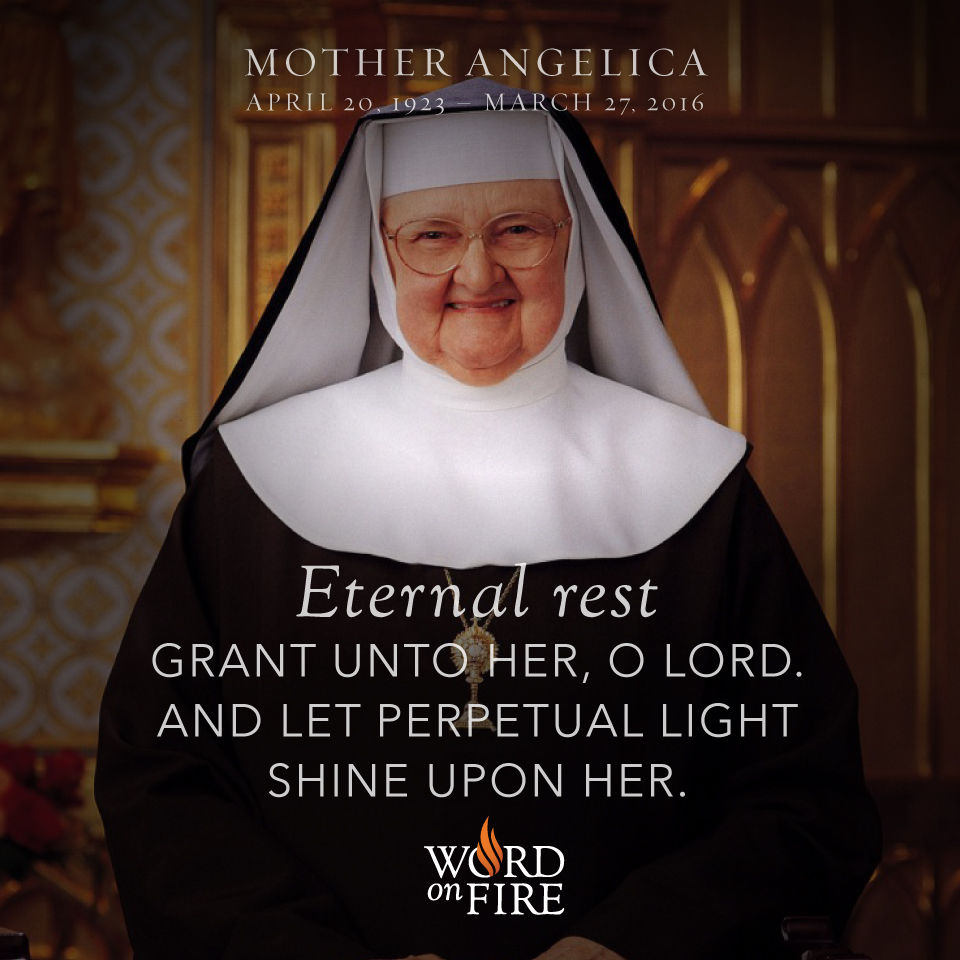Mother Angelica, one of the most significant figures in the post-conciliar Catholic Church in America, has died after a fourteen-year struggle with the after effects of a stroke. I can attest that, in “fashionable” Catholic circles during the eighties and nineties of the last century, it was almost de rigueur to make fun of Mother Angelica. She was a crude popularizer, an opponent of Vatican II, an arch-conservative, a culture-warrior, etc., etc. And yet while her critics have largely faded away, her impact and influence are uncontestable. Against all odds and expectations, she created an evangelical vehicle without equal in the history of the Catholic Church. Starting from, quite literally, a garage in Alabama, EWTN now reaches 230 million homes in over 140 countries around the world. With the possible exception of John Paul II himself, she was the most watched and most effective Catholic evangelizer of the last fifty years.
Read Raymond Arroyo’s splendid biography in order to get the full story of how Rita Rizzo, born and raised in a tough neighborhood in Canton, Ohio, came in time to be a nun, a foundress, and a television personality. For the purposes of this brief article, I would like simply to draw attention to three areas of particular spiritual importance in the life of Mother Angelica: her trust in God’s providence, her keen sense of the supernatural quality of religion, and her conviction that suffering is of salvific value.
The accounts of the beginning of EWTN read like the stories of some of the great saintly founders of movements and orders within the Church. Mother had a blithe confidence that if God called her to do something, he would provide what was needed. Her right hand man, Deacon Bill Steltemeier, a lawyer and businessman who would prove indispensable in getting the operation of EWTN off the ground, came to her in the most remarkable way. While in Chicago for a convention, he saw a flyer advertising a speech at a local parish by a nun whom he did not know. For some reason, he felt compelled to attend. Despite typically horrific Chicago winter weather and though he had no real idea where he was going, he made it to the parish and caught the second half of the nun’s presentation. Just as she was finishing up, he heard a voice saying quietly but insistently, “until the day you die.” The nun, of course, was Mother Angelica. Deacon Bill interrupted his prosperous legal career, drove to Alabama, and presented himself to Mother, who calmly said, “I’ve been expecting you!” The voice, by the way, proved prophetic, for Deacon Bill died just a few years ago, having indeed served EWTN literally until his last day.
Some years later, Mother ordered a giant satellite dish in order dramatically to increase the reach of her network. When the device arrived, the driver of the truck demanded the money on the spot. Mother asked to be excused for a few minutes and went to her chapel to pray: “Lord, I thought you wanted this satellite thing; now give me the money I need!” As she went out to speak to the driver, one of her sisters ran up announcing, “There is a man on the phone who says he wants to give you a donation.” It was a gentlemen calling from a yacht in the Bahamas who said he suddenly had the inspiration to send Mother Angelica $600,000!
The second theme upon which I’d like to focus is her instinct for the supernatural dimension of Christianity. Now I realize that such an instinct might seem rather obvious, but in the immediately post-conciliar years there was indeed a tendency to naturalize the supernatural, to reduce Christianity to the works of social justice and the cultivation of psychological well-being. Mother knew that a de-supernaturalized Christianity would in short order lose its soul and, paradoxically, its relevance to the world. Accordingly, she brought to the fore prayer, liturgy, the sacraments, sacramentals, the saints, adoration of the Eucharist, spiritual warfare, etc. And as someone who worked in the seminary world for twenty years, I can testify that this is precisely what made her talks and programs attractive to a younger generation of Catholics, who found much of liberal Catholicism indistinguishable from secular political and self-help programs.
The third and final motif I would stress is Mother Angelica’s penetrating understanding of the value of suffering. As Arroyo’s biography makes eminently clear, Mother endured tremendous suffering, both physical and psychological, most of her life, and she appreciated these trials as opportunities for spiritual growth. Nowhere was this clearer for her than in the last fourteen years of her life, as this once very vocal and active and woman accepted silence and immobility. She told one of her sisters some years ago that if she got much sicker, she wanted every possible means employed to keep her alive, not because she was clinging to life, but “because I will have suffered one more day for the love of God.” I often thought of Mother, during the last years of her life, as a kind of Mother Drexel for our time. That great foundress, after suffering a heart attack at 75, spent the last twenty years of her life praying for the order that she had established.
Mother Angelica wasn’t perfect—and she would be the first to admit it. Due to her lack of polish and advanced theological education, she sometimes said things that were insufficiently nuanced and balanced. And her hot temper, which gave fire to her evangelization, also at times led her to indulge in ad hominem attacks and unfair characterizations of her opponents’ positions. But these are quibbles. When Church historians write their accounts of the years immediately following Vatican II, Rita Rizzo of Canton, Ohio, Mother Angelica, will find a very honored place.
Bishop Robert Barron is an auxiliary bishop of the Archdiocese of Los Angeles and the founder of Word on Fire Catholic Ministries.

